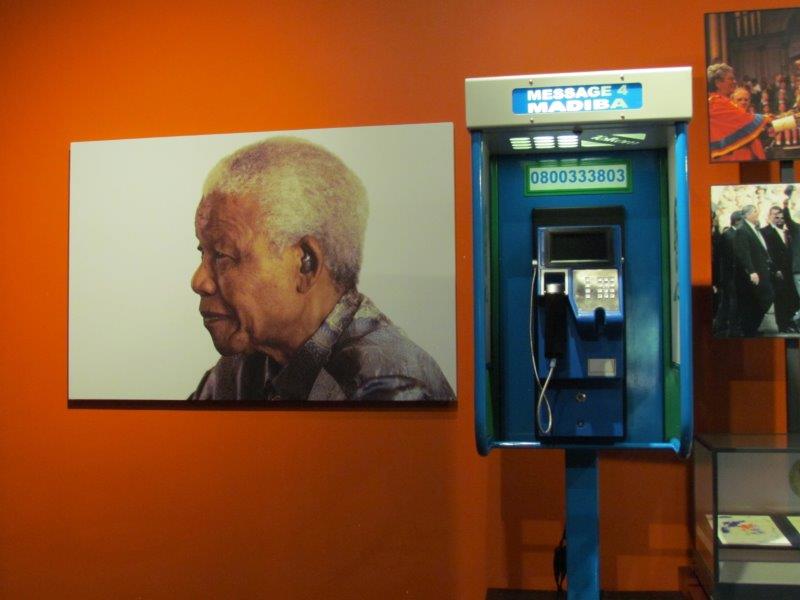It’s always good to know a few words in a local language, but that could be a challenge in Johannesburg, a city with 11 official languages. Our guide, T.K. Motosogi, from JMT Tours suggested that we learn a little Zulu, as it’s the most widely spoken. So we learned sawubona for hello, ngiyacela and ngiyabonga for please and thank you, as we drove in from OR Tambo International airport to our hotel in the Sandton area.
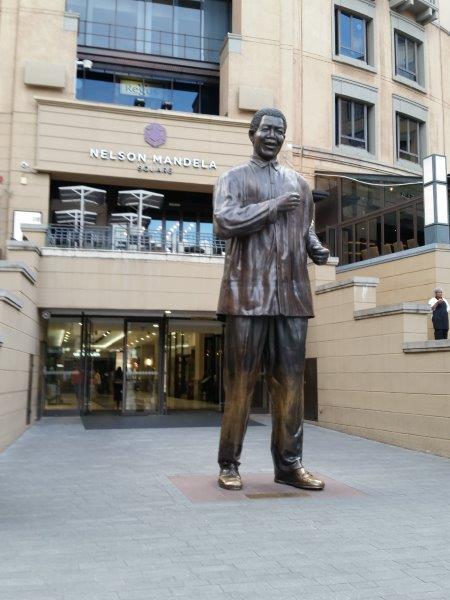
The first statue of former South African President Nelson Mandela in Johannesburg – photo Debra Smith
Sawubona Johannesburg
Also known as Jozi or Joberg, Johannesburg is home to 4.4 million people (10 million if you include Greater Johannesburg). It’s the capital of Gauteng province, known as “the place of gold”. It was the epicentre of the gold rush of 1886 that drew 100,000 people to the region over ten years. At one point the mines delivered 40% of the world’s entire gold supply. The influx of mainly white settlers and international fortune hunters led to the Second Boer War with Britain, and later to oppressive government regimes. Nelson Mandela, South Africa’s first black President, made his home here after his release from prison. Joberg is a truly international city and one of the world’s leading financial centres.
In 2009, the United Nations declared July 18 Nelson Mandela Day and 2018 is a special celebration, as it marks the 100th anniversary of his birth. The day is a call to action to make the world a better place, starting in our communities. Former President Barack Obama will deliver the 16th annual Nelson Mandela Lecture, and three museums in Johannesburg are part of the new Mandela Trail in South Africa.
On the Mandela Trail
We left behind the modern high-rises and office towers of Sandton and took a 45-minute drive to the leafy shaded streets of Soweto. An abbreviation of South West Townships, Soweto was once the centre of resistance to the apartheid regime. During the Soweto Uprising in June of 1976 residents refused to have Afrikaans taught in schools instead of their native languages and riots began in the streets. Their protests set the stage for the end of the apartheid system in the 1980’s.
Soweto is now a popular tourist destination. About a quarter of Johannesburg’s population lives here, and there are 264 private schools, a university, two hospitals, 14 police stations and 150 churches in the neighbourhood.
As part of a tour, we had the pleasure of visiting Phafogang Secondary School to present the staff with two new computers and some school supplies. Like all teenagers, the 600 students were happy to have a break from their usual schedule, and some were eager to chat with us and strike a pose for photographs. Donations to schools are always welcome and can be arranged through tour guides or dropped off at local churches.
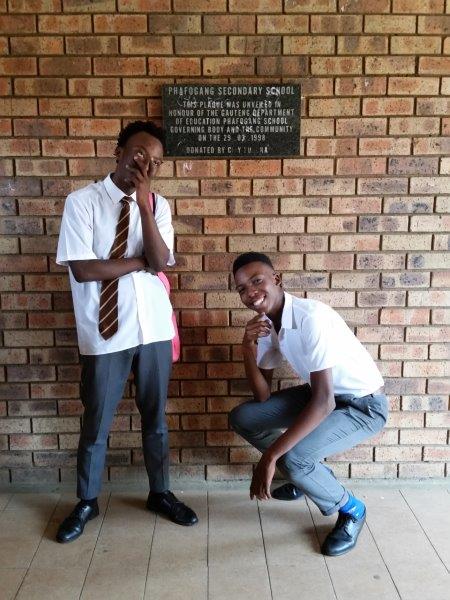
Students at Phafogang School in Soweto – photo Debra Smith
We stopped for lunch at the Shakhumzi Restaurant and then walked a few doors down to Mandela House, the modest home where Nelson Mandela lived before his imprisonment. It’s full of paintings, photographs and personal mementoes, like the world champion wrestling belt he received from Sugar Ray Leonard. This small brick house, where Mandela lived with his wife Winnie, is a place of homage for his followers. “It was the opposite of grand, but it was my first true home of my own, and I was mightily proud. A man is not a man until he has a house of his own”, he wrote in his book The Long Walk to Freedom.
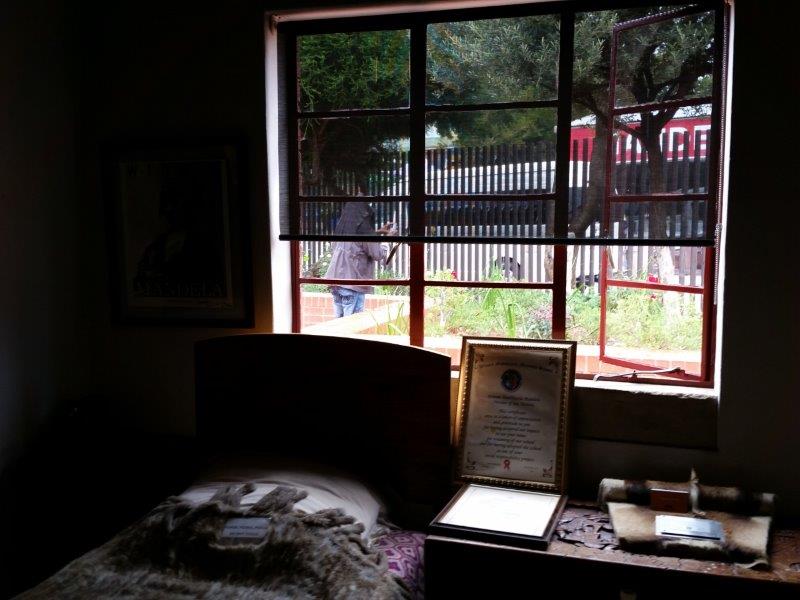
Mandela’s bedroom at the Nelson Mandela Museum in Soweto
For insights into Mandela’s private and political life, we visited the Nelson Mandela Foundation Center of Memory which has recently opened its doors to the public. Mandela’s career is celebrated through film, artefacts and state-of-the-art interactive exhibits. At the Message 4 Mandiba phone booth, for instance, you can hear heartfelt messages that people have left for Mandela, or leave your own. (Mandiba was his Xhosa clan name.) The office where he advocated for peace and met with international dignitaries has been preserved as he left it on the day he retired in 2004.
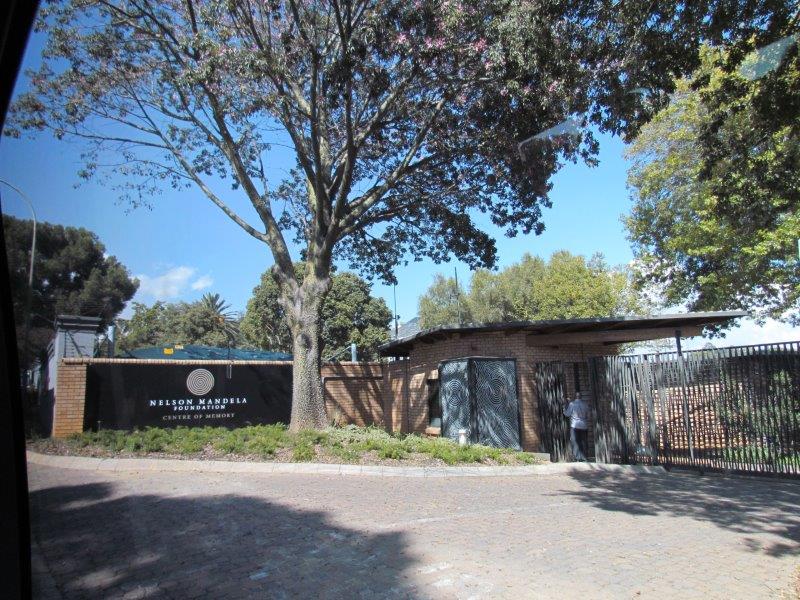
The life and career of Mandela explored at the Nelson Mandela Foundation Centre for Memory – photo Debra Smith
The sun was casting lace shadows through the trees onto the concrete walkway when we arrived at the Apartheid Museum. Dedicated to an in-depth examination of the anti-apartheid movement, this new building tells its stories through its architecture as well as exhibitions. From the moment you choose which door to use to enter the building, Whites or Non-Whites, you are immersed in the story of the struggle for freedom. The 22 permanent exhibitions explore this dark period in history from every angle: cultural, historical and political. The end of the era came with the National Peace Accord of 1991 and South Africa’s first democratic elections in 1994, followed by the Truth and Reconciliation Commission, in 1996. Artefacts, photographs, recordings and video bring the conflict into focus and highlight the champions, both black and white, of the anti-apartheid movement.
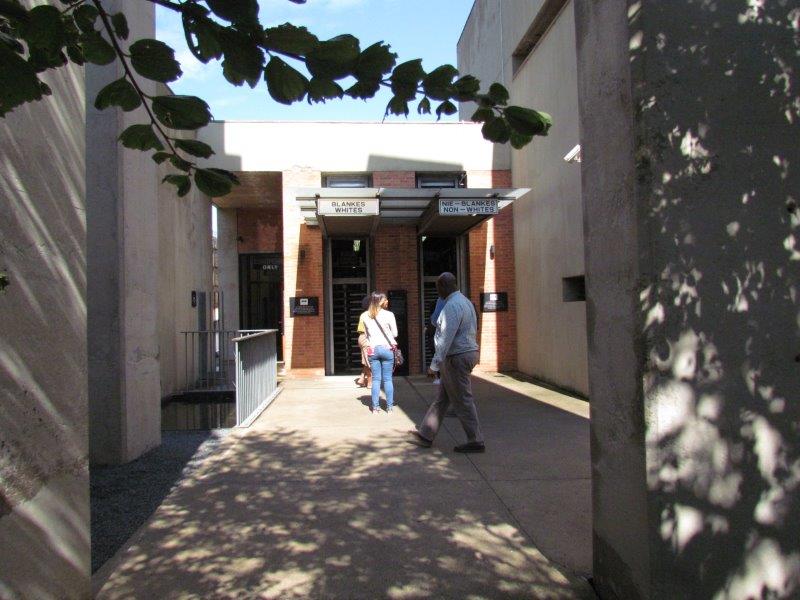
The thought-provoking entrance to the Apartheid Museum in Johannesburg – photo Debra Smith
As for learning Zulu, I think T.K. was pulling our leg. We hardly made use of our new found language skills since everyone we met spoke English. It’s used everywhere, including the museums.
Cheap Eats and Upscale Treats in Johannesburg
In Soweto: The Shakhumzi Restaurant bills itself as an authentic Soweto experience and the tasty buffet lives up to its reputation. It features traditional foods like samp, (mashed corn and beans), lamb stew, bread dumplings and malva pudding for dessert, an apricot based warm cake that’s a local favourite, served with custard. An energetic dance troupe dressed in ethnic costumes entertains with songs and dances.
In Sandton: Pigalle, an upscale dining experience on Nelson Mandela Square, specialises in Portuguese inspired dishes and fresh seafood along with the ubiquitous malva pudding. Take a selfie in the square with the 6 metre (20 ft.) tall bronze statue of Nelson Mandela, the first one ever erected in South Africa.
Sleepover in Sandton
The five star Sandton Sun offers “gentle luxury” with 326 rooms and suites overlooking the tree-filled suburbs of the Sandton business district. Décor is modern, with embossed wallpaper and accents of grey satin, complemented by crystal chandeliers. Guests will find a full mini-bar, flat screen TV, a Nespresso machine and USB plugs along with 24-hour room service. Perfect for business folk but popular with families, the hotel has an outstanding breakfast buffet, (high chairs are available) and a huge outdoor patio. There’s an equally large patio lounge, perfect for nights spent with good conversation and cocktails under the stars. Shoppers can explore the attached Sandton City Shopping Centre featuring over 300 stores including Louis Vuitton, Apple, Hugo Boss and Zara. There is also a food court, several restaurants and a movie theatre. Connections from the hotel to OR Tambo airport by Gautrain are complimentary.
The writer was a guest of South African Tourism while in South Africa. As always, her opinions are her own. For more photographs of Johannesburg, follow her on Instagram @where.to.lady

